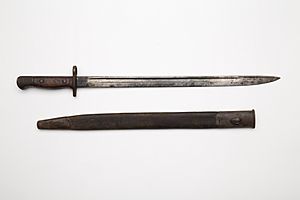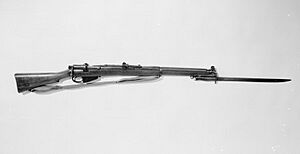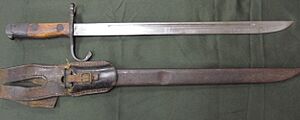Pattern 1907 bayonet facts for kids
Quick facts for kids Sword bayonet, Pattern 1907 |
|
|---|---|

Pattern 1907 bayonet with scabbard.
|
|
| Type | Bayonet |
| Place of origin | United Kingdom |
| Service history | |
| In service | 20th century |
| Used by | British Empire |
| Wars | World War I World War II |
| Production history | |
| Designed | 1906–1907 |
| Manufacturer | James A. Chapman, Robert Mole & Sons, Sanderson Bros & Newbould Ltd, Vickers Ltd and Wilkinson Sword |
| Produced | 1908–1945 |
| No. built | More than 5,000,000 |
| Specifications | |
| Mass | 16+1⁄2 oz (470 g) |
| Length | 21+3⁄4 in (550 mm) |
| Blade length | 17 in (430 mm) |
| References | Australian War Memorial and Ballard & Bennett |
The Pattern 1907 bayonet was a special knife or sword that attached to the end of a rifle. Its official name was the Sword bayonet, pattern 1907 (Mark I). This bayonet was made in Britain and designed to be used with the Short Magazine Lee Enfield (SMLE) rifle. Soldiers from Britain and other countries in the British Empire used it. It was an important tool during both World War I and World War II.
Contents
How the Bayonet Was Made
The Pattern 1907 bayonet had a single piece of steel for its blade and handle part (called a tang). The handguard (called a crossguard) and the end of the handle (called a pommel) were made from strong iron or steel. The part you held, the grip, was usually made of walnut wood. Two screws held the wooden grip to the tang.
The whole bayonet was about 55.2 centimeters (21.75 inches) long. It weighed around 468 grams (16.5 ounces). Early versions made before 1913 had a special hook on the lower part of the crossguard. This hook was meant to catch an enemy's bayonet. However, this idea didn't work well in real fights. So, after 1913, the hook was removed for a simpler design. Sometimes, even older bayonets had their hooks removed when they were sent for repairs.
The blade of the Pattern 1907 bayonet was about 43.2 centimeters (17 inches) long. Both sides of the blade had a shallow groove, called a fuller. This groove made the blade lighter and stronger. It was about 30.5 centimeters (12 inches) long and stopped about 7.6 centimeters (3 inches) from the tip.
The bayonet came with a simple leather scabbard (a cover for the blade). This scabbard had steel parts at the top and bottom. Soldiers usually carried it on their belt using a simple loop. The Pattern 1907 bayonet attached to the SMLE rifle in a specific way. It had a special slot on its pommel that fit onto a part of the rifle. When the bayonet was attached, the rifle and bayonet together were about 1.57 meters (5 feet 2 inches) long.
Special Marks on the Bayonet
Bayonets had special marks stamped onto the blade near the handle (called the ricasso). These marks showed where and when they were made. On British bayonets, the right side had an 'X' mark, which meant it passed a bend test. It also had a "broad arrow" mark, showing it was accepted by the government. There were also marks from inspectors.
On the left side, you could see the date the bayonet was officially checked. It also showed the maker's name and the king's symbol. For example, "ER" meant Edward Rex (King Edward VII). After 1910, "GR" meant Georgius Rex (King George V).
Bayonets made in India had "GRI" (Georgius Rex Imperator) for the king's symbol. Their maker's mark was 'R.F.I.' for the Rifle Factory Ishapore. Australian bayonets had marks like the Lithgow Company Shield, 'MA' (Lithgow Small Arms Factory), or 'OA' (Orange Feeder Factory). During World War II, the wooden grips of Australian bayonets often had 'SLAZ' marked on them. This was because Slazenger made those grips.
History of the Bayonet
When the British military started using the Short Magazine Lee-Enfield rifle, its barrel was shorter than older rifles. This made some military leaders worried. They thought British soldiers might be at a disadvantage in bayonet fights. This was because enemy soldiers might have longer rifles and bayonets.
Bayonet fighting was a very important part of a British soldier's training back then. Soldiers practiced different ways to stand and block attacks with their rifles and bayonets. The SMLE rifle with the older Pattern 1903 bayonet was about 1.45 meters (4 feet 9 inches) long. This was shorter than the French Lebel Model 1886 (1.83 meters or 6 feet) and the German Mauser 1898 (1.77 meters or 5 feet 10 inches).
Because of this, the British Army looked for a new, longer bayonet in 1906–1907. They tested different designs, including a changed version of the Japanese Type 30 bayonet. The tests led to the British Army creating its own version of the Type 30 bayonet. This new design was called the Sword bayonet, pattern 1907 (Mark I). It was officially introduced on January 30, 1908.
About 5 million Pattern 1907 bayonets were made in Britain during World War I. Companies like Wilkinson Sword and Vickers Ltd were some of the makers. An American company, Remington UMC, also made about 100,000 of them. The bayonet was also made in India from 1911 to 1940 and in Australia from 1913 to 1945.
The Pattern 1907 bayonet was used by most countries in the British Commonwealth along with the SMLE rifle. It was used a lot in battles until 1945, serving in both World War I and World War II. It stayed in use in Australia and India for some time after 1945. In 1926, its name was changed to 'Bayonet, No.1, Mk.1'.
Different Types of Pattern 1907 Bayonets
Over time, some similar bayonets were developed.
Pattern 1913 Bayonet
The Pattern 1913 bayonet was made for a test rifle called the Pattern 1913 Enfield. The only real difference from the Pattern 1907 bayonet was a longer crossguard. This was needed to fit the Pattern 1913 Enfield rifle. When World War I started, the British changed the Pattern 1913 Enfield to use the .303 British bullet. This new rifle was called the Pattern 1914 Enfield. American companies like Winchester and Remington made these rifles and their bayonets. To avoid confusion with the Pattern 1907 bayonet, two deep grooves were cut into the wooden grips of the Pattern 1913 bayonet.
Model 1917 Bayonet
When the United States joined World War I, they also used the Pattern 1914 Enfield rifle. They changed it to use their own .30-06 Springfield bullet. This new rifle was called the Model 1917 Enfield. To go with it, the U.S. simply used the Pattern 1913 bayonet and called it the Model 1917 bayonet. More than 2 million of these were made in the U.S. during the war. Some were even Pattern 1913 bayonets that were just re-stamped. The Model 1917 bayonet was also used with U.S. Army combat shotguns. It stayed in U.S. service until the 1980s.
India Pattern Bayonets
Starting in 1941, India began making shorter versions of the Pattern 1907 bayonet. They cut them down to about 31 centimeters (12.2 inches) and sharpened the tip. These were called the India Pattern No. 1 Mk. I*. Another version, the India Pattern No. 1 Mk. I**, was very similar but had a short false edge on top. You can tell these apart because the fuller (the groove) runs the whole length of the blade.
The India Pattern No. 1 Mk. II and India Pattern No. 1 Mk. II* were new bayonets made with 31-centimeter blades. They didn't have the fuller. The Mk. II* also had a false edge. Both kept the same handle and grip as the Pattern 1907. Finally, the India Pattern No. 1 Mk. III and India Pattern No. 1 Mk. III* were like the Mk. II and Mk. II* but had simpler, square-shaped handles and rectangular grips. They were often painted black.
See also
- Sword bayonet




